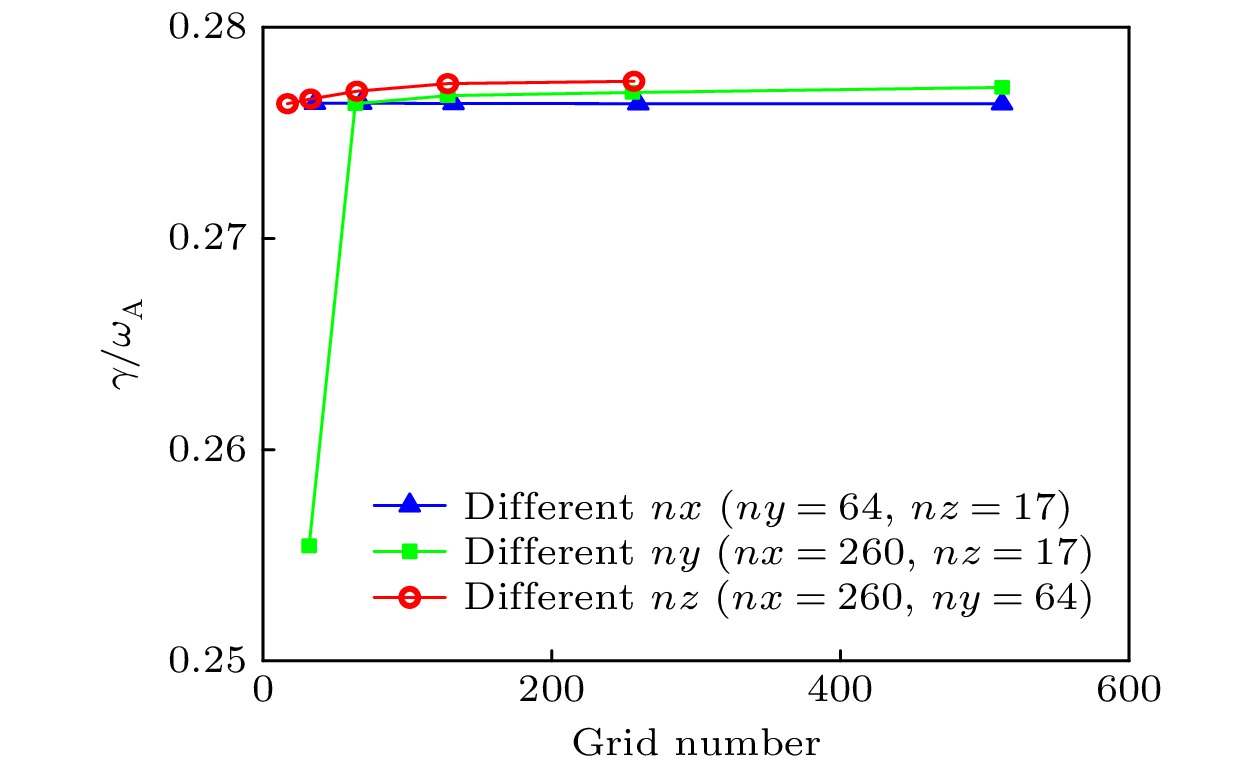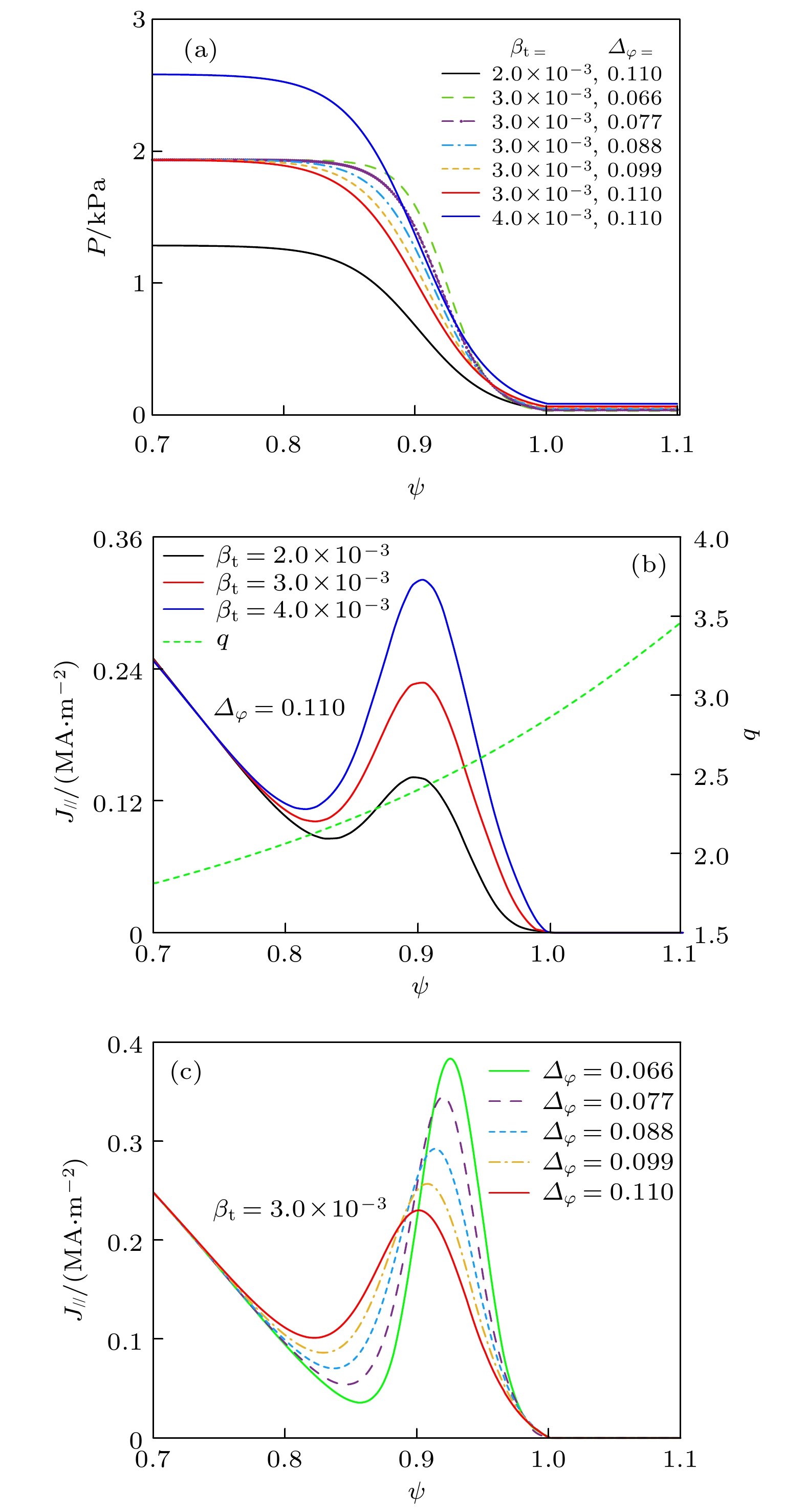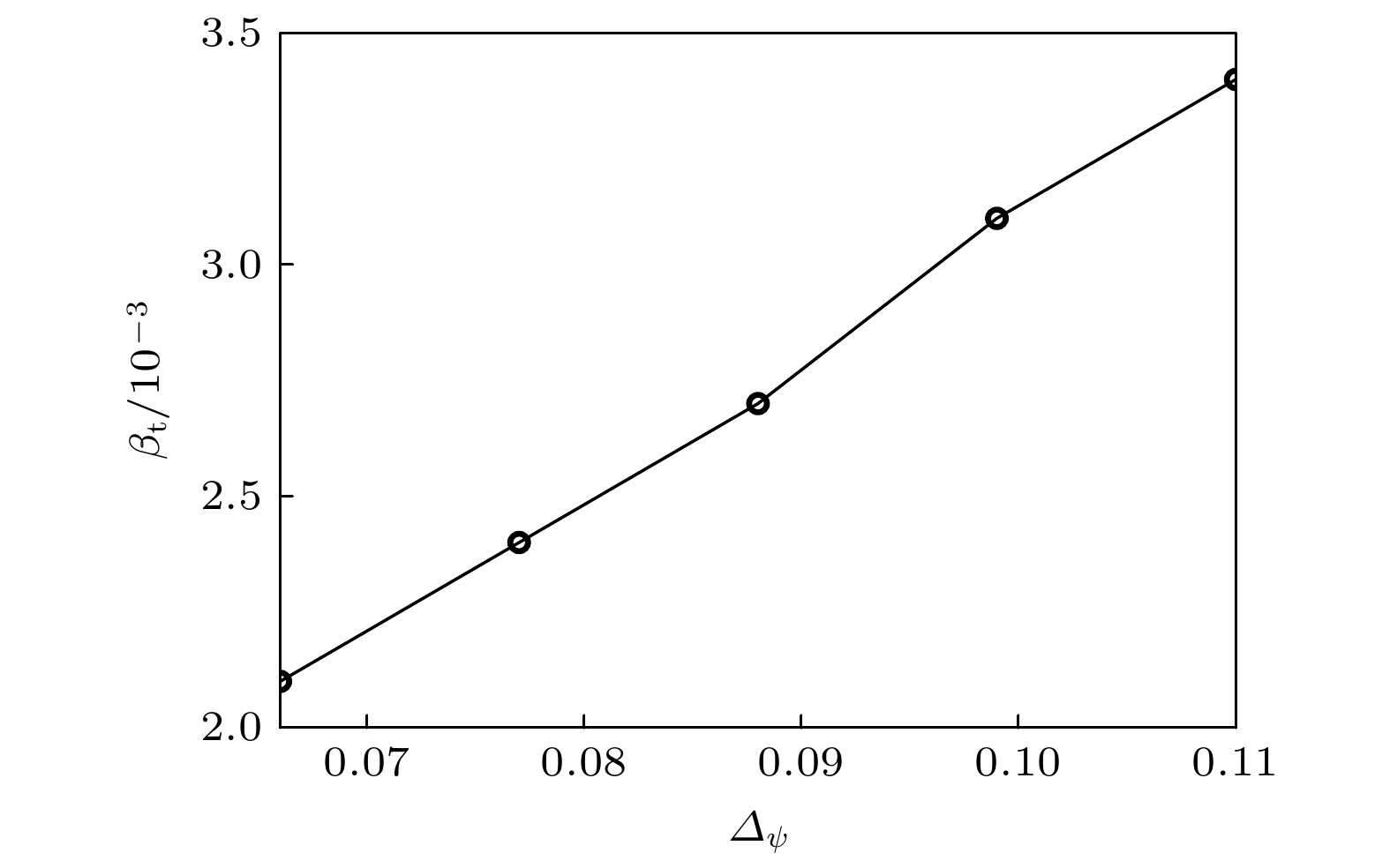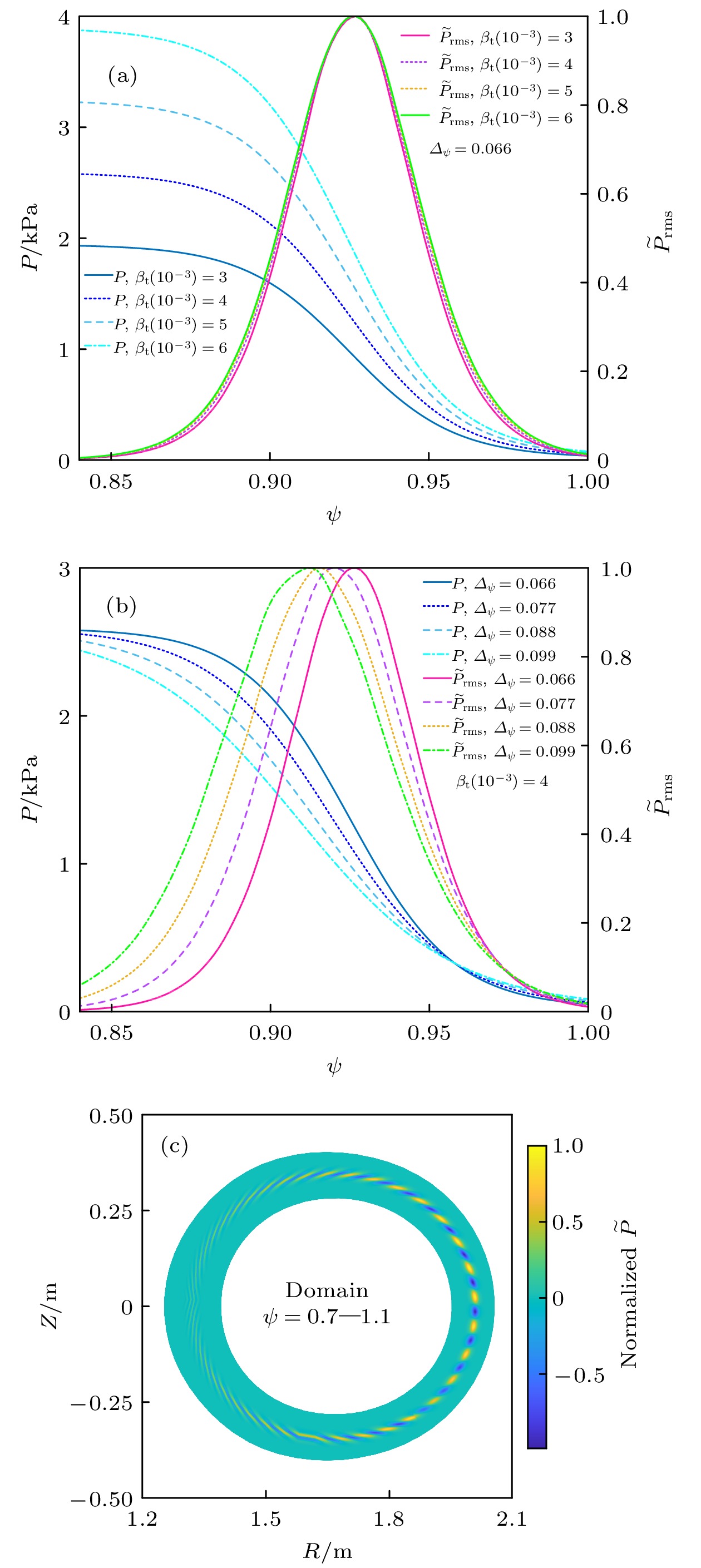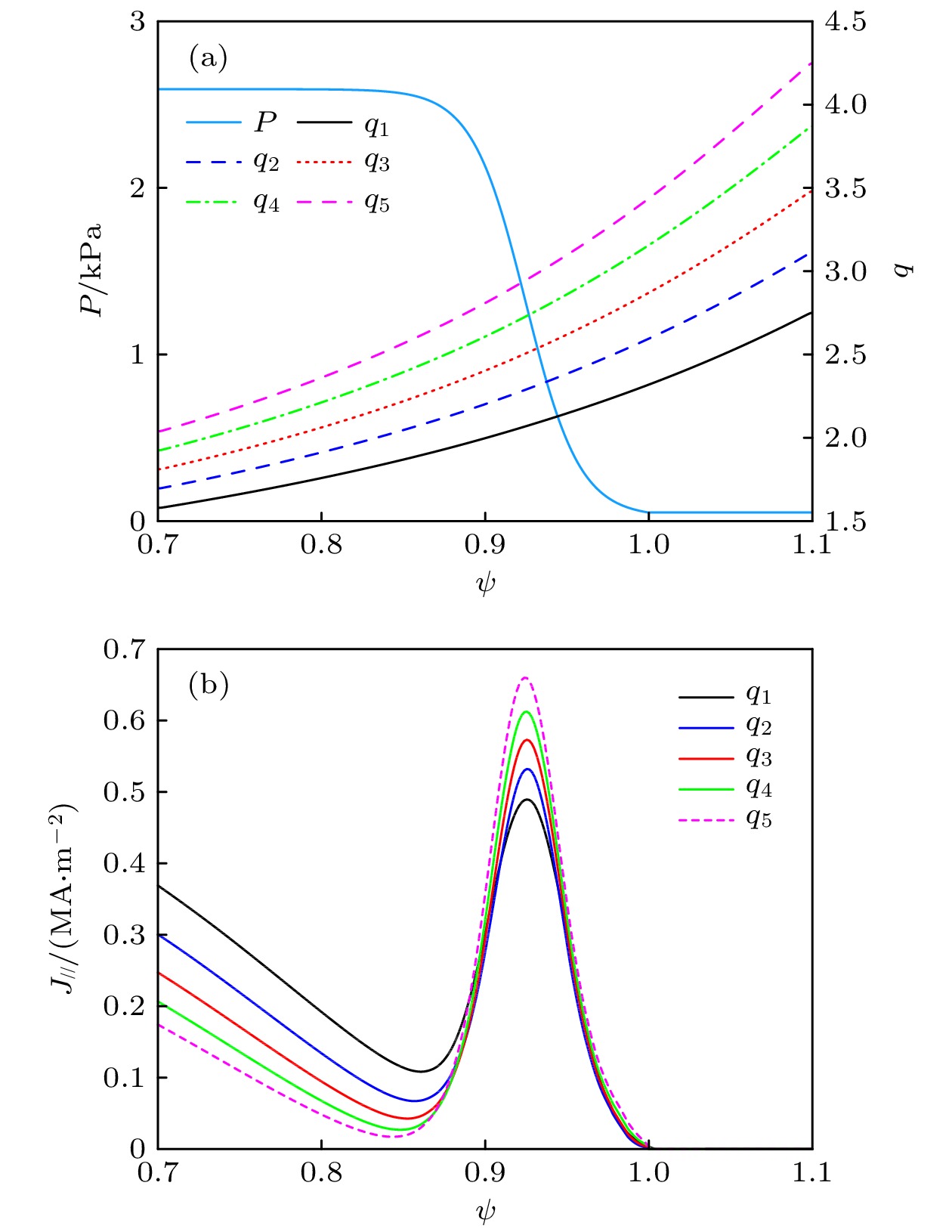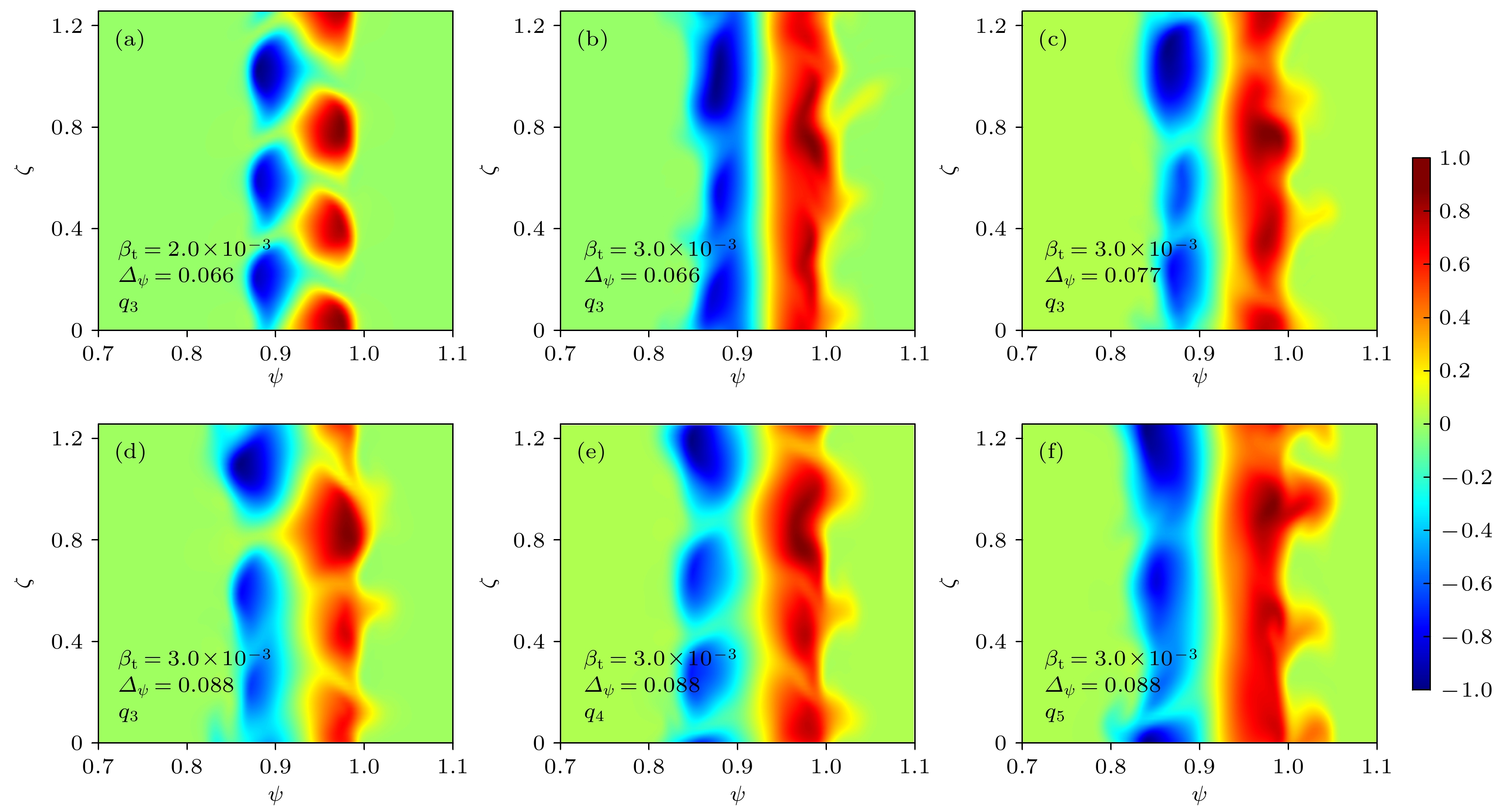-
HL-2A tokamak achieved the first ELMy H-mode discharge operation in 2009 under divertor configuration, and many experimental and simulation researches have been carried out to investigate the pedestal magnetohydrodynamic (MHD) instability. However, there are still few studies on the effect of pedestal structure on MHD stability. Therefore, based on HL-2A experimental parameters, equilibria with different pedestal structures are generated by using TOQ code, and the MHD stability of the equilibria is simulated by using the BOUT++ three-field module. The linear simulations show that reducing the pedestal height, increasing the pedestal width, reducing the pedestal current density and reducing the ion density in the pedestal can improve the MHD stability of pedestal. Using the theory of dispersion relation, the simulation results are explained. Under the premise of MHD stability, the maximum pedestal heights corresponding to different pedestal widths are found, and the data are fitted to obtain an empirical formula that can predict pedestal height, and on this basis, considering the kinetic ballooning mode theory, pedestal height and width are predicted simultaneously. The effect of the pedestal structure on the MHD mode structure is investigated, it is found that the pedestal height can affect the radial width of the mode. Nonlinear simulations show that the pre-growth of instability is affected mainly by a single dominant mode, and the growth of the dominant mode to a certain size will cause the collapse of the pedestal and the eruption of the edge localized mode (ELM). The variation of ELM size after ELM eruption is synchronized with the evolution of the dominant mode. Generally, equilibria with larger linear growth rates have larger ELM sizes and a wider range of pedestal collapse in nonlinear simulations. In this work, the scanning of the pedestal data focuses mainly on the width and height of the pedestal, and other parameters such as small radius, toroidal magnetic field, plasma current, and the pedestal safety factor values will be changed in the future based on the work in this paper, with the aim of enriching the HL-2A pedestal database and predicting the pedestal structure more accurately. Finally these results will be integrated under the HL-2A integrated platform, which in turn will provide a reference for HL-2A tokamak H-mode experiments and integrated simulations.
-
Keywords:
- HL-2A /
- pedestal height /
- pedestal width /
- MHD stability /
- ELM
[1] ITER Physics Expert Group on Confinement and Transport, ITER Physics Expert Group on Confinement Modelling and Database, ITER Physics Basis Editors 1999 Nucl. Fusion 39 2175
 Google Scholar
Google Scholar
[2] Aymar R, Barabaschi P, Shimomura Y 2002 Plasma Phys. Control. Fusion 44 519
 Google Scholar
Google Scholar
[3] Neuhauser J, Alexander M, Becker G, et al. 1995 Plasma Phys. Control. Fusion 37 A37
 Google Scholar
Google Scholar
[4] Groebner R J, Osborne T H 1998 Phys. Plasmas 5 1800
 Google Scholar
Google Scholar
[5] Connor J W, Hastie R J, Wilson H R, Miller R L 1998 Phys. Plasmas 5 2687
 Google Scholar
Google Scholar
[6] Wu N, Chen S Y, Mou M L, Tang C J 2018 Phys. Plasmas 25 092305
 Google Scholar
Google Scholar
[7] Sun C K, Xu X Q, Ma C H, Li B 2018 Phys. Plasmas 25 082106
 Google Scholar
Google Scholar
[8] Snyder P B, Wilson H R, Ferron J R, Lao L L, Leonard A W, Osborne T H, Turnbull A D, Mossessian D, Murakami M, Xu X Q 2002 Phys. Plasmas 9 2037
 Google Scholar
Google Scholar
[9] Federici G, Andrew P, Barabaschi P, Brooks J, Doerner R, Geier A, Herrmann A, Janeschitz G, Krieger K, Kukushkin A, Loarte A, Neu R, Saibene G, Shimada M, Strohmayer G, Sugihara M 2003 J. Nucl. Mater. 313-316 11
 Google Scholar
Google Scholar
[10] Zohm H 1996 Plasma Phys. Control. Fusion 38 105
 Google Scholar
Google Scholar
[11] Snyder P B, Wilson H R, Ferron J R, Lao L L, Leonard A W, Mossessian D, Murakami M, Osborne T H, Turnbull A D, Xu X Q 2004 Nucl. Fusion 44 320
 Google Scholar
Google Scholar
[12] Wilson H R, Snyder P B, Huysmans G T A, Miller R L 2002 Phys. Plasmas 9 1277
 Google Scholar
Google Scholar
[13] Chance M S, Chu M S, Okabayashi M, Turnbull A D 2002 Nucl. Fusion 42 295
 Google Scholar
Google Scholar
[14] Huysmans G T A, Sharapov S E, Mikhailovskii A B, Kerner W 2001 Phys. Plasmas 8 4292
 Google Scholar
Google Scholar
[15] Dudson B D, Umansky M V, Xu X Q, Snyder P B, Wilson H R 2009 Comput. Phys. Commun. 180 1467
 Google Scholar
Google Scholar
[16] Snyder P B, Aiba N, Beurskens M, Groebner R J, Horton L D, Hubbard A E, Hughes J W, Huysmans G T A, Kamada Y, Kirk A, Konz C, Leonard A W, Lönnroth J, Maggi C F, Maingi R, Osborne T H, Oyama N, Pankin A, Saarelma S, Saibene G, Terry J L, Urano H, Wilson H R 2009 Nucl. Fusion 49 085035
 Google Scholar
Google Scholar
[17] Snyder P B, Groebner R J, Hughes J W, Osborne T H, Beurskens M, Leonard A W, Wilson H R, Xu X Q 2011 Nucl. Fusion 51 103016
 Google Scholar
Google Scholar
[18] Groebner R J, Chang C S, Hughes J W, et al. 2013 Nucl. Fusion 53 093024
 Google Scholar
Google Scholar
[19] 李凯 2020 博士学位论文 (合肥: 中国科学技术大学)
Li K 2020 Ph. D. Dissertation (Hefei: University of Science and Technology of China) (in Chinese)
[20] Xu X Q, Dudson B, Snyder P B, Umansky M V, Wilson H 2010 Phys. Rev. Lett. 105 175005
 Google Scholar
Google Scholar
[21] Xia T Y, Xu X Q, Dudson B D, Li J 2012 Contrib. Plasma Phys. 52 353
 Google Scholar
Google Scholar
[22] Xia T Y, Xu X Q 2013 Phys. Plasmas 20 052102
 Google Scholar
Google Scholar
[23] Xia T Y, Xu X Q, Xi P W 2013 Nucl. Fusion 53 073009
 Google Scholar
Google Scholar
[24] Xu X Q, Dudson B D, Snyder P B, Umansky M V, Wilson H R, Casper T 2011 Nucl. Fusion 51 103040
 Google Scholar
Google Scholar
[25] Duan X R, Dong J Q, Yan L W, Ding X T, Yang Q W, Rao J, Liu D Q, Xuan W M, Chen L Y, Li X D, Lei G J, Cao J Y, Cao Z, Song X M, Huang Y, Liu Yi, Mao W C, Wang Q M, Cui Z Y, Ji X Q, Li B, Li G S, Li H J, Luo C W, Wang Y Q, Yao L H, Yao L Y, Zhang J H, Zhou J, Zhou Y, Liu Yong, HL-2A Team 2010 Nucl. Fusion 50 095011
 Google Scholar
Google Scholar
[26] Duan X R, Liu Yi, Xu M, et al., HL-2 A Team. 2017 Nucl. Fusion 57 102013
 Google Scholar
Google Scholar
[27] Xu M, Duan X R Liu Yi, Song X M, et al., HL2A Team. 2019 Nucl. Fusion 59 112017
 Google Scholar
Google Scholar
[28] Xiao G L, Zhong W L, Zhang Y P, et al., HL-2A Team. 2020 J. Fusion Energy 39 300
 Google Scholar
Google Scholar
[29] Tang T F, Shi H, Wang Z H, Zhong W L, Xia T Y, Xu X Q, Sun J Z, Wang D Z 2018 Phys. Plasmas 25 122510
 Google Scholar
Google Scholar
[30] Wu N, Chen S Y, Mou M L Tang C J, Song X M, Yang Z C, Yu D L, Xu J Q, Jiang M, Ji X Q, Wang S, Li B, Liu L, HL-2 A Team 2018 Phys. Plasmas 25 102505
 Google Scholar
Google Scholar
[31] Ma J F, Xu X Q, Dudson B D 2014 Nucl. Fusion 54 033011
 Google Scholar
Google Scholar
[32] Xi P W, Xu X Q, Xia T Y, Nevins W M, Kim S S 2013 Nucl. Fusion 53 113020
 Google Scholar
Google Scholar
[33] Lortz D 1975 Nucl. Fusion 15 49
 Google Scholar
Google Scholar
[34] Huang Y Q, Xia T Y, Gui B 2018 Plasma Sci. Technol. 20 045101
 Google Scholar
Google Scholar
[35] 简翔 2018 博士学位论文 (武汉: 华中科技大学)
Jian X 2018 Ph. D. Dissertation (Wuhan: Huazhong University of Science and Technology) (in Chinese)
-
图 4 台基高度
${\beta _{\rm{t}}}$ 为$2.0\times {10}^{-3},\, 3.0\times {10}^{-3}$ 和$4.0\times {10}^{-3} $ , 台基宽度${\varDelta _\psi }$ 为0.066, 0.077, 0.088, 0.099和0.110时的压强(a) 、平行电流和安全因子(b)(c)剖面Figure 4. Pressure (a), parallel current density and safety factor profiles (b)(c) with pedestal heights
${\beta _{\rm t}}$ of$2.0 \times {10^{ - 3}}, $ $ 3{\text{.0}} \times {10^{ - 3}}$ and$4.0 \times {10^{ - 3}}$ , and pedestal widths${\varDelta _\psi }$ of 0.066, 0.077, 0.088, 0.099 and 0.110.图 5 理想MHD线性增长率 (a) 台基高度
${\beta _{\rm t}}$ 分别为$2.0\times {10}^{-3},\, 3.0\times {10}^{-3}$ 和4.0 × 10–3, 台基宽度${\varDelta _\psi }$ = 0.110; (b) 台基高度$ {\beta _{\rm t}} = 3.0 \times {10^{ - 3}} $ , 台基宽度${\varDelta _\psi }$ 分别为0.066, 0.077, 0.088, 0.099和0.110Figure 5. Linear growth rates with different pedestals: (a) Pedestal heights
${\beta _{\rm t}}$ are$2.0 \times {10^{ - 3}}$ ,${\text{3}}{\text{.0}} \times {10^{ - 3}}$ and$4.0 \times {10^{ - 3}}$ , while pedestal width${\varDelta _\psi }$ is 0.110; (b) pedestal height${\beta _{\rm t}}$ is${\text{3}}{\text{.0}} \times {10^{ - 3}}$ while pedestal widths${\varDelta _\psi }$ are 0.066, 0.077, 0.088, 0.099 and 0.110.图 7 (a) 台基高度
${\beta _{\rm t}}$ 分别为$3.0 \times {10^{ - 3}},\, {\text{ }}4.0 \times {10^{ - 3}}, $ $ {\text{ }}5.0 \times {10^{ - 3}}$ 和$ 6.0 \times {10^{ - 3}} $ , 台基宽度${\varDelta _\psi }$ 为 0.066,$ n = 15 $ 的归一化径向模结构; (b) 台基高度$ {\beta _{\rm t}} = 4.0 \times {10^{ - 3}} $ , 台基宽度${\varDelta _\psi }$ 分别为0.066, 0.077, 0.088和0.099,$ n = 15 $ 的归一化径向模结构; (c) 台基高度$ {\beta _{\rm t}} = 4.0 \times $ $ {10^{ - 3}} $ , 台基宽度${\varDelta _\psi }$ = 0.066,$ n = 15 $ 的归一化二维模结构Figure 7. (a) The normalized radial mode structure of
$ n = 15 $ when pedestal heights${\beta _{\rm t}}$ are$3.0 \times {10^{ - 3}},\, 4{\text{.0}} \times {10^{ - 3}},\,5.0 \times $ $ {10^{ - 3}}$ and$6.0 \times {10^{ - 3}}$ , while pedestal width${\varDelta _\psi }$ is 0.088; (b) the normalized radial mode structure of$ n = 15 $ when pedestal height$ {\beta _{\rm t}} $ is$ 4.0 \times {10^{ - 3}} $ , pedestal widths${\varDelta _\psi }$ are 0.066, 0.077, 0.088 and 0.099 respectively; (c) the normalized two-dimensional mode structure of$ n = 15 $ when pedestal height${\beta _{\rm t}}$ is$ 4.0 \times {10^{ - 3}} $ and pedestal width${\varDelta _\psi }$ is$0.066$ 图 9 (a) 不同安全因子的条件下, 剥离-气球模(PBM)稳定性限制下的台基高度和宽度的关系, 以及动理学气球模(KBM)稳定性限制下的台基高度和宽度的关系, 两者的交点即为台基高度和宽度的预测值; (b) 剥离-气球模(PBM)稳定性约束拟合直线的斜率
$k$ 和截距$b$ 随${q_{95}}$ 的变化Figure 9. (a) Relationship between the pedestal height and width under the stability constraints of peeling-ballooning mode (PBM), and relationship between the pedestal height and width under the stability of constraint of kinetic ballooning mode (KBM), the insterection of the two is the predicted value of pedestal height and width; (b) the slope
$k$ and intercept$b$ of the fitting lines with the stability constraints of peeling-ballooning model (PBM) vary with${q_{95}}$ .图 10 在考虑抗磁效应时, 具有不同离子密度的剥离-气球模增长率, 台基高度
${\beta _{\rm t}} = 4.0 \times {10^{ - 3}}$ , 台基宽度${\varDelta _\psi }$ = 0.066Figure 10. When the diamagnetic drift effect is included, linear growth rates of peeling-ballooning modes with different ion densities, while pedestal height
${\beta _{\rm t} } = 4.0 \times {10^{ - 3}}$ and pedestal width${\varDelta _\psi }$ = 0.066.图 11 不同台基结构和安全因子剖面的ELM尺寸 (a) 台基高度
$ {\beta _{\rm t} } $ 分别为$ 2.0 \times {10^{ - 3}} $ 、2.5$ \times {10^{ - 3}} $ 和$ 3.0 \times {10^{ - 3}} $ , 台基宽度${\varDelta _\psi }$ 分别为0.066, 0.077和0.088, 安全因子剖面为图8(a)中的$ {q_3} $ ; (b) 台基高度${\beta _{\rm t} } = 3.0 \times {10^{ - 3}}$ , 台基宽度${\varDelta _\psi }$ = 0.088, 安全因子剖面分别为图8(a)中的$ {q_3} $ 、$ {q_4} $ 和${q_5}$ Figure 11. ELM size corresponding to different pedestal structures and safety factor profiles: (a)
${\beta _{\rm t} }$ are$ 2.0 \times {10^{ - 3}} $ ,$ 2.5 \times {10^{ - 3}} $ and$3.0 \times {10^{ - 3}}$ ,${\varDelta _\psi }$ = 0.066, 0.077, 0.088, while safety factor profile is the${q_3}$ profile in Fig. 8(a); (b)${\beta _{\rm t} }$ is$3.0 \times {10^{ - 3}}$ ,${\varDelta _\psi }$ is$0.088$ , while safety factor profiles are the${q_3}$ ,${q_4}$ and${q_5}$ profiles in Fig. 8(a).图 12 当台基高度
${\beta _{\rm t} } = 3.0 \times {10^{ - 3}}$ , 台基宽度${\varDelta _\psi }$ = 0.088, 安全因子剖面为图8(a)中的${q_4}$ 时, 归一化的扰动压强在径向$\psi $ 和环向$\zeta $ 平面随时间的演化Figure 12. Evolution of pressure perturbation in the frame of normalized poloidal flux
$\psi $ and toroidal angle$\zeta $ with pedestal height${\beta _{\rm t} } = 3.0 \times {10^{ - 3}}$ and pedestal width${\varDelta _\psi }$ = 0.088, while safety factor profile is the${q_4}$ profile in figure 8(a).图 17 固定台基高度
${\beta _{\rm t}} = 3.0 \times {10^{ - 3}}$ 和台基宽度${\varDelta _\psi }$ = 0.088, 当安全因子剖面不同时, 非线性模拟中$t = 195{\tau _{\rm A} }$ 时刻磁面平均的总压强分布Figure 17. Fixed
${\beta _{\rm t}} = 3.0 \times {10^{ - 3}}$ ,${\varDelta _\psi }$ = 0.088, when safety factor profiles are different, the surface-averaged pressure profiles distribution at$t = 195{\tau _{\rm A}}$ in the nonlinear simulations. -
[1] ITER Physics Expert Group on Confinement and Transport, ITER Physics Expert Group on Confinement Modelling and Database, ITER Physics Basis Editors 1999 Nucl. Fusion 39 2175
 Google Scholar
Google Scholar
[2] Aymar R, Barabaschi P, Shimomura Y 2002 Plasma Phys. Control. Fusion 44 519
 Google Scholar
Google Scholar
[3] Neuhauser J, Alexander M, Becker G, et al. 1995 Plasma Phys. Control. Fusion 37 A37
 Google Scholar
Google Scholar
[4] Groebner R J, Osborne T H 1998 Phys. Plasmas 5 1800
 Google Scholar
Google Scholar
[5] Connor J W, Hastie R J, Wilson H R, Miller R L 1998 Phys. Plasmas 5 2687
 Google Scholar
Google Scholar
[6] Wu N, Chen S Y, Mou M L, Tang C J 2018 Phys. Plasmas 25 092305
 Google Scholar
Google Scholar
[7] Sun C K, Xu X Q, Ma C H, Li B 2018 Phys. Plasmas 25 082106
 Google Scholar
Google Scholar
[8] Snyder P B, Wilson H R, Ferron J R, Lao L L, Leonard A W, Osborne T H, Turnbull A D, Mossessian D, Murakami M, Xu X Q 2002 Phys. Plasmas 9 2037
 Google Scholar
Google Scholar
[9] Federici G, Andrew P, Barabaschi P, Brooks J, Doerner R, Geier A, Herrmann A, Janeschitz G, Krieger K, Kukushkin A, Loarte A, Neu R, Saibene G, Shimada M, Strohmayer G, Sugihara M 2003 J. Nucl. Mater. 313-316 11
 Google Scholar
Google Scholar
[10] Zohm H 1996 Plasma Phys. Control. Fusion 38 105
 Google Scholar
Google Scholar
[11] Snyder P B, Wilson H R, Ferron J R, Lao L L, Leonard A W, Mossessian D, Murakami M, Osborne T H, Turnbull A D, Xu X Q 2004 Nucl. Fusion 44 320
 Google Scholar
Google Scholar
[12] Wilson H R, Snyder P B, Huysmans G T A, Miller R L 2002 Phys. Plasmas 9 1277
 Google Scholar
Google Scholar
[13] Chance M S, Chu M S, Okabayashi M, Turnbull A D 2002 Nucl. Fusion 42 295
 Google Scholar
Google Scholar
[14] Huysmans G T A, Sharapov S E, Mikhailovskii A B, Kerner W 2001 Phys. Plasmas 8 4292
 Google Scholar
Google Scholar
[15] Dudson B D, Umansky M V, Xu X Q, Snyder P B, Wilson H R 2009 Comput. Phys. Commun. 180 1467
 Google Scholar
Google Scholar
[16] Snyder P B, Aiba N, Beurskens M, Groebner R J, Horton L D, Hubbard A E, Hughes J W, Huysmans G T A, Kamada Y, Kirk A, Konz C, Leonard A W, Lönnroth J, Maggi C F, Maingi R, Osborne T H, Oyama N, Pankin A, Saarelma S, Saibene G, Terry J L, Urano H, Wilson H R 2009 Nucl. Fusion 49 085035
 Google Scholar
Google Scholar
[17] Snyder P B, Groebner R J, Hughes J W, Osborne T H, Beurskens M, Leonard A W, Wilson H R, Xu X Q 2011 Nucl. Fusion 51 103016
 Google Scholar
Google Scholar
[18] Groebner R J, Chang C S, Hughes J W, et al. 2013 Nucl. Fusion 53 093024
 Google Scholar
Google Scholar
[19] 李凯 2020 博士学位论文 (合肥: 中国科学技术大学)
Li K 2020 Ph. D. Dissertation (Hefei: University of Science and Technology of China) (in Chinese)
[20] Xu X Q, Dudson B, Snyder P B, Umansky M V, Wilson H 2010 Phys. Rev. Lett. 105 175005
 Google Scholar
Google Scholar
[21] Xia T Y, Xu X Q, Dudson B D, Li J 2012 Contrib. Plasma Phys. 52 353
 Google Scholar
Google Scholar
[22] Xia T Y, Xu X Q 2013 Phys. Plasmas 20 052102
 Google Scholar
Google Scholar
[23] Xia T Y, Xu X Q, Xi P W 2013 Nucl. Fusion 53 073009
 Google Scholar
Google Scholar
[24] Xu X Q, Dudson B D, Snyder P B, Umansky M V, Wilson H R, Casper T 2011 Nucl. Fusion 51 103040
 Google Scholar
Google Scholar
[25] Duan X R, Dong J Q, Yan L W, Ding X T, Yang Q W, Rao J, Liu D Q, Xuan W M, Chen L Y, Li X D, Lei G J, Cao J Y, Cao Z, Song X M, Huang Y, Liu Yi, Mao W C, Wang Q M, Cui Z Y, Ji X Q, Li B, Li G S, Li H J, Luo C W, Wang Y Q, Yao L H, Yao L Y, Zhang J H, Zhou J, Zhou Y, Liu Yong, HL-2A Team 2010 Nucl. Fusion 50 095011
 Google Scholar
Google Scholar
[26] Duan X R, Liu Yi, Xu M, et al., HL-2 A Team. 2017 Nucl. Fusion 57 102013
 Google Scholar
Google Scholar
[27] Xu M, Duan X R Liu Yi, Song X M, et al., HL2A Team. 2019 Nucl. Fusion 59 112017
 Google Scholar
Google Scholar
[28] Xiao G L, Zhong W L, Zhang Y P, et al., HL-2A Team. 2020 J. Fusion Energy 39 300
 Google Scholar
Google Scholar
[29] Tang T F, Shi H, Wang Z H, Zhong W L, Xia T Y, Xu X Q, Sun J Z, Wang D Z 2018 Phys. Plasmas 25 122510
 Google Scholar
Google Scholar
[30] Wu N, Chen S Y, Mou M L Tang C J, Song X M, Yang Z C, Yu D L, Xu J Q, Jiang M, Ji X Q, Wang S, Li B, Liu L, HL-2 A Team 2018 Phys. Plasmas 25 102505
 Google Scholar
Google Scholar
[31] Ma J F, Xu X Q, Dudson B D 2014 Nucl. Fusion 54 033011
 Google Scholar
Google Scholar
[32] Xi P W, Xu X Q, Xia T Y, Nevins W M, Kim S S 2013 Nucl. Fusion 53 113020
 Google Scholar
Google Scholar
[33] Lortz D 1975 Nucl. Fusion 15 49
 Google Scholar
Google Scholar
[34] Huang Y Q, Xia T Y, Gui B 2018 Plasma Sci. Technol. 20 045101
 Google Scholar
Google Scholar
[35] 简翔 2018 博士学位论文 (武汉: 华中科技大学)
Jian X 2018 Ph. D. Dissertation (Wuhan: Huazhong University of Science and Technology) (in Chinese)
Catalog
Metrics
- Abstract views: 7065
- PDF Downloads: 98
- Cited By: 0














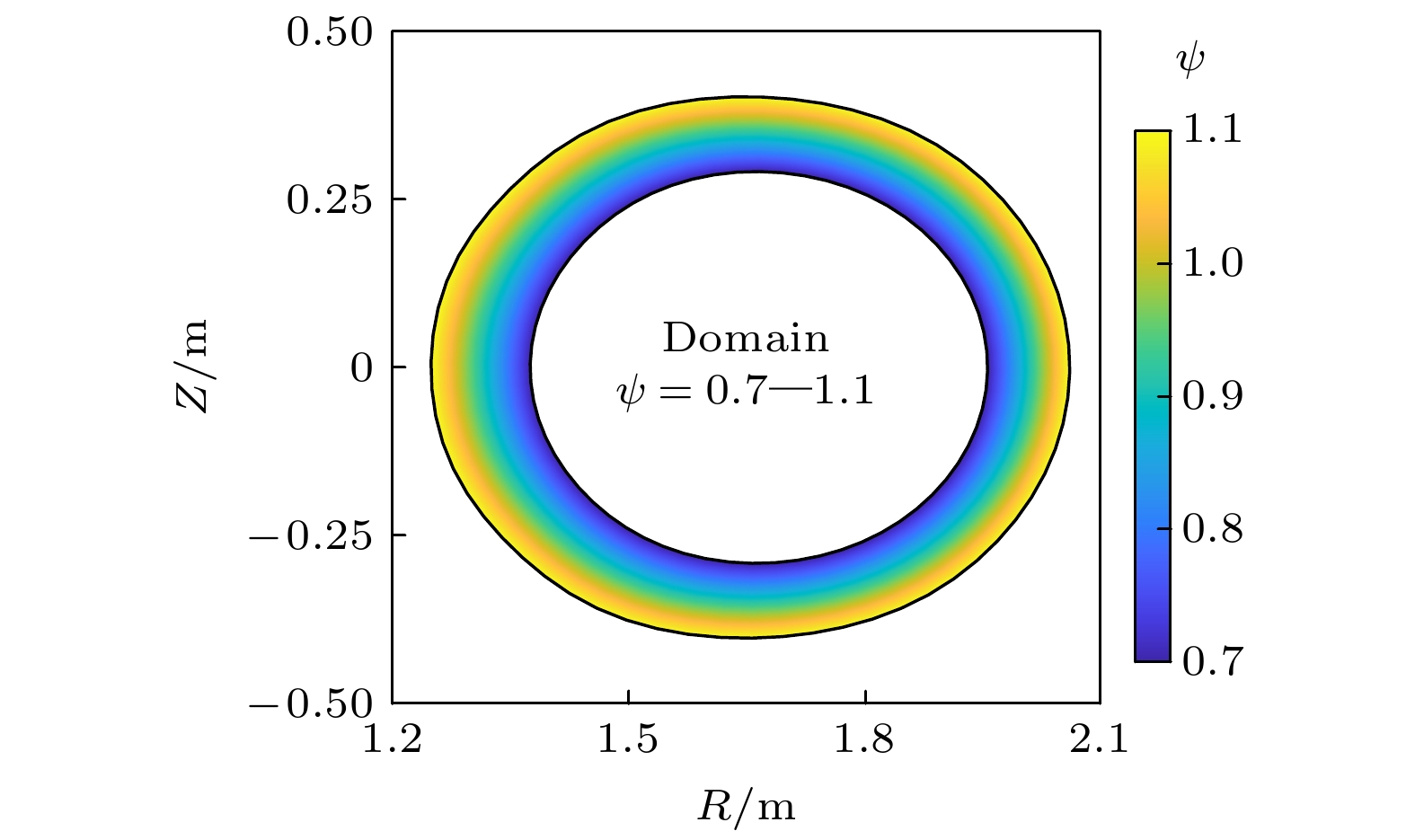
 DownLoad:
DownLoad:





